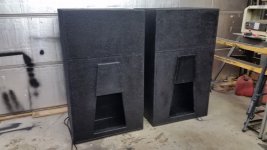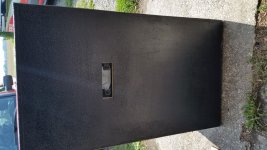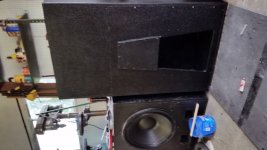I'm surprised that no-one's pointed out that you made those cabinets with MDF instead of birch-ply...
MDF is bludy heavy, and even a little bit of moisture can destroy your creation. It's not really the best choice for PA subwoofer boxes. Painting them inside and out might reduce the moisture problem.
MDF is bludy heavy, and even a little bit of moisture can destroy your creation. It's not really the best choice for PA subwoofer boxes. Painting them inside and out might reduce the moisture problem.
Brian,
Yes I knew they were going to be heavy but choose MDF for a couple of reasons.
1. It is actually MR (moisture resistant) MDF.
2. Used good quality Duratex paint for extra protection.
3. Where I live, Birch-Ply was more than 3x the price of the MR MDF.
4. Even with Birch, they are still heavy, and I will only be moving them a few times a year. So I think I can deal with the bit extra weight.
regards
Yes I knew they were going to be heavy but choose MDF for a couple of reasons.
1. It is actually MR (moisture resistant) MDF.
2. Used good quality Duratex paint for extra protection.
3. Where I live, Birch-Ply was more than 3x the price of the MR MDF.
4. Even with Birch, they are still heavy, and I will only be moving them a few times a year. So I think I can deal with the bit extra weight.
regards
Dane,But I did find the culprit for the mistake (see pic)
Art, I'm not sure how close to 1500w RMS my amps will really output. I think probably closer to 1000w, but that is still too much if sustained. I will mostly be playing Rock/Metal, so a little less demanding then EDM.
Is it possible to set approx limits by ear? I mean listen until it starts to sound a bit distorted, then back it off a little?
The DR260 does have a RMS limiter and a Peak Stop limiter, but from what I have read it aint that good. Without proper RMS limiters I'm kinda guessing anyway I suppose.
Dane
That "culprit" didn't drink itself 😉
Most of us can accept quite a bit of LF distortion before finding it unacceptable, by the time you would reach even 10% THD, a sustained tone could fry the coils. An AC voltmeter and sine wave tones will be needed to set the voltage you decide to let through.
The DR260 limiter has an attack .01 to 200 m Sec, the speed at which the limiter starts to limit the signal once it has crossed the threshold. If set to the longest attack time with a relatively low threshold, it should clamp down for sustained tones, yet still allow peak impact.
Cheers,
Art
Dane,
That "culprit" didn't drink itself 😉
Pretty sure I remember it pleading with me to drink it. It's exact words... " I love you, drink me". SO it is its fault 😉
Ok hearing distortion not a reliable way. Thanks
I wasn't sure about the AC multi-meter test. I'll work on using that method.
Dane
I wasn't sure about the AC multi-meter test. I'll work on using that method.
Dane
Too many replies to sift through to find the actual quote.
But I distinctly remember that a KS utilizing a 15 could be made 20% less wide...(.though lower dB)...but still have the same FR.
Just checking into this thread to make sure I'm not imagining things...
Btw, I built two KS subs using the b&c 18s (non-neo)..and before break-in, I almost wept thinking things weren't right...but after a week of solid break-in...these things are beasts!
But I distinctly remember that a KS utilizing a 15 could be made 20% less wide...(.though lower dB)...but still have the same FR.
Just checking into this thread to make sure I'm not imagining things...
Btw, I built two KS subs using the b&c 18s (non-neo)..and before break-in, I almost wept thinking things weren't right...but after a week of solid break-in...these things are beasts!
A 20% reduction would be a 21.2 inch wide cabinet, your distinct memory might be dyslexic ;^).But I distinctly remember that a KS utilizing a 15 could be made 20% less wide...(.though lower dB)...but still have the same FR.
...but after a week of solid break-in...these things are beasts!
The cabinet could be reduced in width, utilizing 15" or 18" drivers with a reduction in output, but the Keystone exit would have to be adjusted to retain the same frequency response. I doubt the adjustment of the exit would be linear to the width reduction to maintain the same frequency response.
Seems most of the people building the Keystone run them at levels that would "break in" the driver in a few hours, but glad to hear yours are housebroken!
Cheers,
Art
LOL Indeed! ..good stuff Art..😀
But dyslexia it sorta was, the 20% figure was for an increase in size, using dual 15's, not a reduction for using one.
Original quotes from post #1, and post #168 in case someone else runs into same question:
And bolded ..is this still your starting guess? I'm still considering experimenting, so clarification would be great.
As far as breaking the B&Cs in, I must not have hit them with much power then...
Haven't measured anything yet...just playing tunes through an old AVR I have in my shop, feeding the sub-outs into a NU-6000, solid lights on bottom 2 LEDs, and kick-drum blinking the 3rd.
Even after about an hour of that (loud to my ears), the motor structure is cool as can be, no warming whatsoever.
Speaking of which, can someone point me to a thread or link that spells out what I need to determine how much voltage/wattage I'm feeding to a driver in a high-power/PA type scenario, and for testing them in general for that matter.. (?)
I have REW, 2 measurement mics (usb and XLR with cal files), but have only really tested on a low-power/home type scenario, so jumper-wires, resistors etc. are of that same low-power variety.
Enough now, the 'cousin of culprit' is knocking on my door, and it's Friday..😀
Have a great weekend all.. -Steve
Couple pics here, really like this Herculiner polyurethane paint, tuff stuff!
But dyslexia it sorta was, the 20% figure was for an increase in size, using dual 15's, not a reduction for using one.
Original quotes from post #1, and post #168 in case someone else runs into same question:
Making a slightly wider cabinet would allow two 15 inch speakers to fit, which would probably allow about 3 or 4 dB more output at the low corner, and 5 or 6 dB more upper level with only about 20% increase in cabinet size.
Reducing cabinet width may actually be an improvement for a 15", but you will need to experiment with the exit size. As a starting guess, I'd reduce the exit dimensions by the same % as the cabinet width and height are reduced.
And bolded ..is this still your starting guess? I'm still considering experimenting, so clarification would be great.
As far as breaking the B&Cs in, I must not have hit them with much power then...
Haven't measured anything yet...just playing tunes through an old AVR I have in my shop, feeding the sub-outs into a NU-6000, solid lights on bottom 2 LEDs, and kick-drum blinking the 3rd.
Even after about an hour of that (loud to my ears), the motor structure is cool as can be, no warming whatsoever.
Speaking of which, can someone point me to a thread or link that spells out what I need to determine how much voltage/wattage I'm feeding to a driver in a high-power/PA type scenario, and for testing them in general for that matter.. (?)
I have REW, 2 measurement mics (usb and XLR with cal files), but have only really tested on a low-power/home type scenario, so jumper-wires, resistors etc. are of that same low-power variety.
Enough now, the 'cousin of culprit' is knocking on my door, and it's Friday..😀
Have a great weekend all.. -Steve
Couple pics here, really like this Herculiner polyurethane paint, tuff stuff!
Attachments
1) Reducing the width should not have much effect on Fb, but reducing height would shorten the path length, which would. The Eminence 15" I used when originally making the comment did not work well with the stock Keystone, while the Dayton 15 later used in the taller version had quite similar frequency response to the BC18TBW100.1) Reducing cabinet width may actually be an improvement for a 15", but you will need to experiment with the exit size. As a starting guess, I'd reduce the exit dimensions by the same % as the cabinet width and height are reduced.
And bolded ..is this still your starting guess? I'm still considering experimenting, so clarification would be great.
2) Speaking of which, can someone point me to a thread or link that spells out what I need to determine how much voltage/wattage I'm feeding to a driver in a high-power/PA type scenario, and for testing them in general for that matter.. (?)
2) You can get a good idea of the peak watt output simply using the meters on your amplifier, the NU6000 hits 3000 watts into 4 ohms when the "0/limit" lights, the -6 dB light would be around 750 watts, -12dB 187 watts, -24 12 watts.
Depending on the crest factor of the material being played, the average power could be equal for a sine wave type signal (3 dB crest factor) or as little as 5% for music with a wide dynamic range.
Art
Seems most of the people building the Keystone run them at levels that would "break in" the driver in a few hours, but glad to hear yours are housebroken!
Cheers,
Art
Probably the reason why they are called woofers in the first place 😀
Single Amp possible?
I'm looking into driving 4 Keystone subs - two in parallel on each channel - with a single Powersoft K20 (or even a K10). I have 18SW115-4s in the subs. I was wondering if I could run into potential problems then doing that, since it's a lot of power running into 2Ohms. Because if one driver fails...the other one on the same Channel is not going to like it. The idea is to reduce the rack size and weight to a minimum.
I'm looking into driving 4 Keystone subs - two in parallel on each channel - with a single Powersoft K20 (or even a K10). I have 18SW115-4s in the subs. I was wondering if I could run into potential problems then doing that, since it's a lot of power running into 2Ohms. Because if one driver fails...the other one on the same Channel is not going to like it. The idea is to reduce the rack size and weight to a minimum.
Aardvark87,I'm looking into driving 4 Keystone subs - two in parallel on each channel - with a single Powersoft K20 (or even a K10). I have 18SW115-4s in the subs. I was wondering if I could run into potential problems then doing that, since it's a lot of power running into 2Ohms.
The K10 does 6000 (peak) into 2 ohms, 3000 per driver compared to 4000 at 4 ohms, less than 1 dB difference.
The K20 does 9000 into 2 ohms, 4500 per driver compared to 5200 at 4 ohms, again less than 1 dB difference.
If you are worried about blowing a second speaker because of a one dB difference in level to it, set the limiters so you don't blow the first speaker 😉
Cheers,
Art
Hey art,
Aardvark87,
The K10 does 6000 (peak) into 2 ohms, 3000 per driver compared to 4000 at 4 ohms, less than 1 dB difference.
The K20 does 9000 into 2 ohms, 4500 per driver compared to 5200 at 4 ohms, again less than 1 dB difference.
If you are worried about blowing a second speaker because of a one dB difference in level to it, set the limiters so you don't blow the first speaker 😉
Cheers,
Art
We don't have a "tapped horn" anything like what we designed.what happens if we don't bend the horn path inside the box?
What i mean is, part g and h in the plan is not straight and has a certain angle to it. What happens if i don't follow that and make it straight?
If you change all the parts to have 90 degree angles rather then the angles as designed, the cabinet frequency response will change.What happens if i don't follow that and make it straight?
The change probably won't be for the better 😉
- Home
- Loudspeakers
- Subwoofers
- Keystone Sub Using 18, 15, & 12 Inch Speakers


